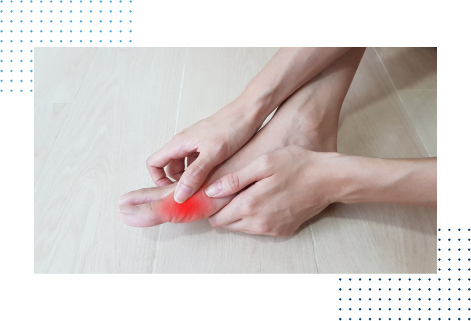Diseases We Treat

Conditions treated
Gout
Gout is the most common inflammatory arthritis that affects men. It belongs to a group of arthropathies called ‘the crystalline arthropathies’. Gout is caused by a robust inflammatory response to uric acid crystals which occurs in the setting of high uric acid levels in the blood. High uric acid levels can occur for a variety of reasons but most often related to genetic susceptibility and kidney insufficiency. In the past patients were told that gout occurred because of a poor diet, but this notion has been sufficiently disproven. Supersaturation of uric acid can lead to crystal accumulation and deposition in the joints and tissues to which the immune system reacts. In some patient with chronic refractory gouty arthritis, uric acid tophi (dense collections of crystals) appear as hard nodules under the skin and can lead to significant discomfort along with bone and joint destruction.
At AOC our providers take a proactive approach to treating gouty arthritis. In fact our center does feature a Gout Center of Excellence (GCE). Read below for the details of our GCE.
Why a Gout Center of Excellence (GCE)?
Our practice has a keen interest in diagnosing and treating gout. Gout is one of the most common inflammatory arthritis syndromes. Thanks to some great researchers, over the years the medical and rheumatology community has gained considerable insight about a number of details surrounding the disease: which patients are at risk, how best to diagnose, underpinnings of what causes the disease and the development of very effective medical treatments. We also understand that it is extremely important to treat gouty arthritis aggressively as a chronic disease since the disease can lead to joint damage and disability.What are the Philosophies, unique practices and offerings of our gout center?
- We recognize that Gouty arthritis can be difficult to confirm and properly diagnose. Did you know that just having an elevated uric acid level does not necessarily confirm gouty arthritis? In fact, having an elevated uric acid level is not uncommon, occurring in close to 20% of the population. Of the patients who have high uric acid levels only about 20% will develop gouty arthritis. Furthermore some patients with acute gouty arthritis have falsely lower or even normal levels of uric acid. We are committed to confirming a diagnosis of gouty arthritis. Often times to help confirm the diagnosis our providers will remove fluid from a joint and look at the fluid under our polarized light microscope (not so different from what a geologist would use) to visually confirm the presence of uric acid crystals (see picture). In select cases imagin studies like X-ray, ultrasound, and even DECT scans are ordered.
- We offer evaluations that will be scheduled in a reasonable time frame. Gout is a very painful and potentially damaging disease, so we recognize it is not practical to schedule patients several months out for an appointment.
- We offer early, aggressive therapies for patients with confirmed gouty arthritis. Lower levels of uric acid result in better outcomes in gouty arthritis. It has been very well established that if we are able to reduce the uric acid level to less than 6.0mg/dl, then attacks of gout will decrease. We are committed to monitoring the uric acid levels consistently and frequently if needed to achieve these goals. We have a special interest in treating chronic refractory (sometimes called tophaceous) gouty arthritis and have considerable experience in using the FDA approved uricase , Pegloticase /Krystexxa®.
- We strongly believe Krystexxa® is a medication that will strongly be considered for those patients with severe/chronic tophaceous/refractory gouty arthritis. We strive for streamlined insurance approval processes, full and proactive use of available patient assistance and/or foundation assistance programs. We will make strong efforts to minimize the authorization to infusion time period. We are fully committed to considering immunomodulatory co-treatment with this product to preserve its beneficial effects, improve safety associated with the treatment and lessen the possibility that resistance to the treatment ensues. All patients going on this therapy will be closely monitored with at least one provider visit every 8 weeks. While on this treatment, the uric acid will be checked every 2 weeks, prior to each treatment.